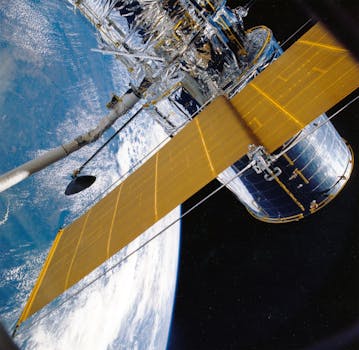
Beyond Earth: How Recent Advances Are Shaping Satellite Telecommunications
Beyond Earth: How Recent Advances Are Shaping Satellite Telecommunications, the world of satellite telecommunications is undergoing a significant transformation. Recent advances in technology have enabled the development of more efficient, cost-effective, and high-performance satellite systems. These advancements have far-reaching implications for the industry, from improved communication services to enhanced navigation and remote sensing capabilities.
The integration of cutting-edge technologies such as artificial intelligence, blockchain, and the Internet of Things (IoT) is playing a crucial role in shaping the future of satellite telecommunications. For instance, AI-powered satellite systems can optimize communication routes, predict and prevent signal interference, and enhance the overall quality of service. Meanwhile, blockchain technology can provide secure and transparent data transmission, while IoT devices can leverage satellite connectivity to enable widespread machine-to-machine communication.
Advances in Satellite Technology
One of the most significant recent advances in satellite technology is the development of high-throughput satellites (HTS). These satellites utilize advanced beam-forming and frequency reuse techniques to provide higher data transfer rates and greater connectivity. HTS have been instrumental in expanding the availability of broadband internet services, particularly in remote and underserved areas. Companies like ViaSat and Hughes Network Systems have been at the forefront of HTS development, launching numerous satellites that offer faster and more reliable internet connectivity.
Another area of significant advancement is in the field of satellite propulsion systems. Traditional chemical propulsion systems are being replaced by more efficient and environmentally friendly alternatives, such as electric and hybrid propulsion systems. These new systems offer improved fuel efficiency, reduced emissions, and increased maneuverability, making them ideal for a range of satellite applications, from Earth observation to communication and navigation.
Impact on the Industry
The recent advances in satellite telecommunications are having a profound impact on the industry. The increased availability of high-speed internet services is bridging the digital divide, connecting more people and communities around the world. This, in turn, is driving economic growth, improving access to education and healthcare, and enabling new opportunities for social and cultural development.
The growth of satellite telecommunications is also driving innovation in other areas, such as space exploration and development. As governments and private companies invest in satellite infrastructure, they are also investing in the development of new space technologies, such as reusable launch vehicles and in-orbit servicing. These advancements are paving the way for more sustainable and efficient space exploration, enabling humans to venture further into space and explore new frontiers.
Challenges and Future Directions
Despite the many advances in satellite telecommunications, there are still significant challenges to be addressed. One of the major concerns is the issue of space debris, which poses a significant threat to the long-term sustainability of satellite operations. As the number of satellites in orbit increases, so does the risk of collisions and the accumulation of debris. To mitigate this risk, companies and governments are investing in debris removal technologies and developing more sustainable satellite designs.
Another challenge facing the industry is the need for greater regulatory clarity and cooperation. As satellite telecommunications become increasingly global, there is a growing need for international cooperation and standardization. Governments and industry stakeholders must work together to develop common standards and regulations, ensuring that satellite systems are safe, secure, and interoperable.